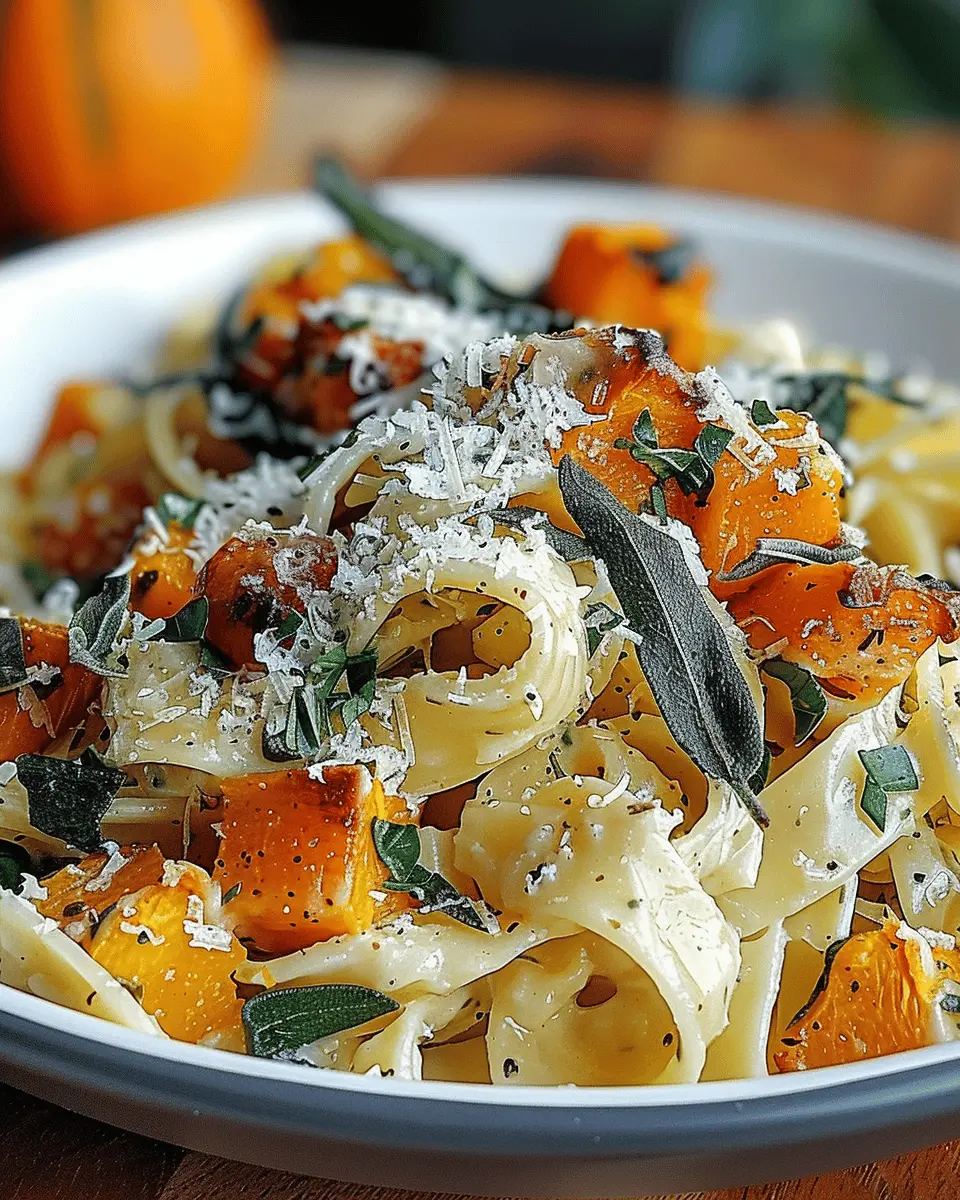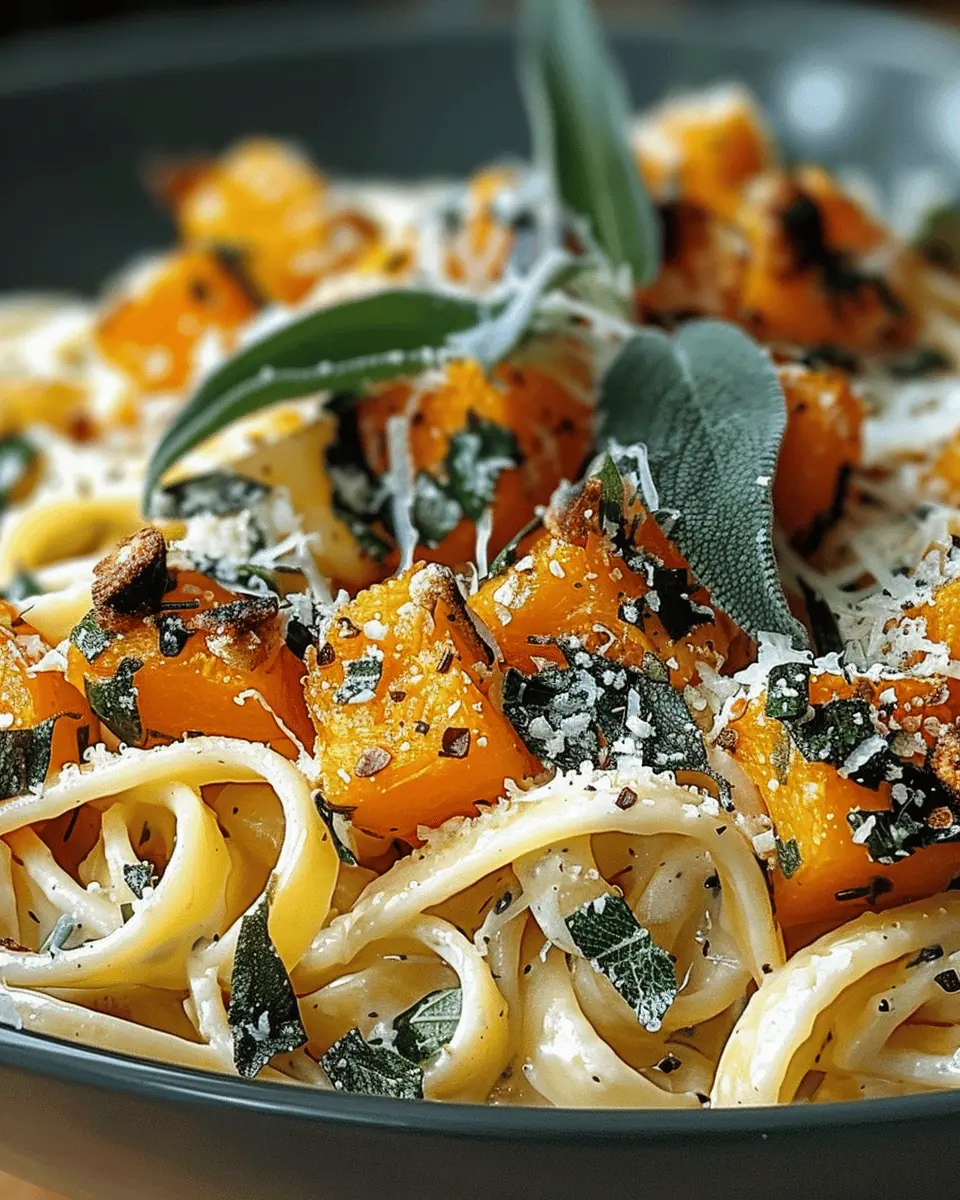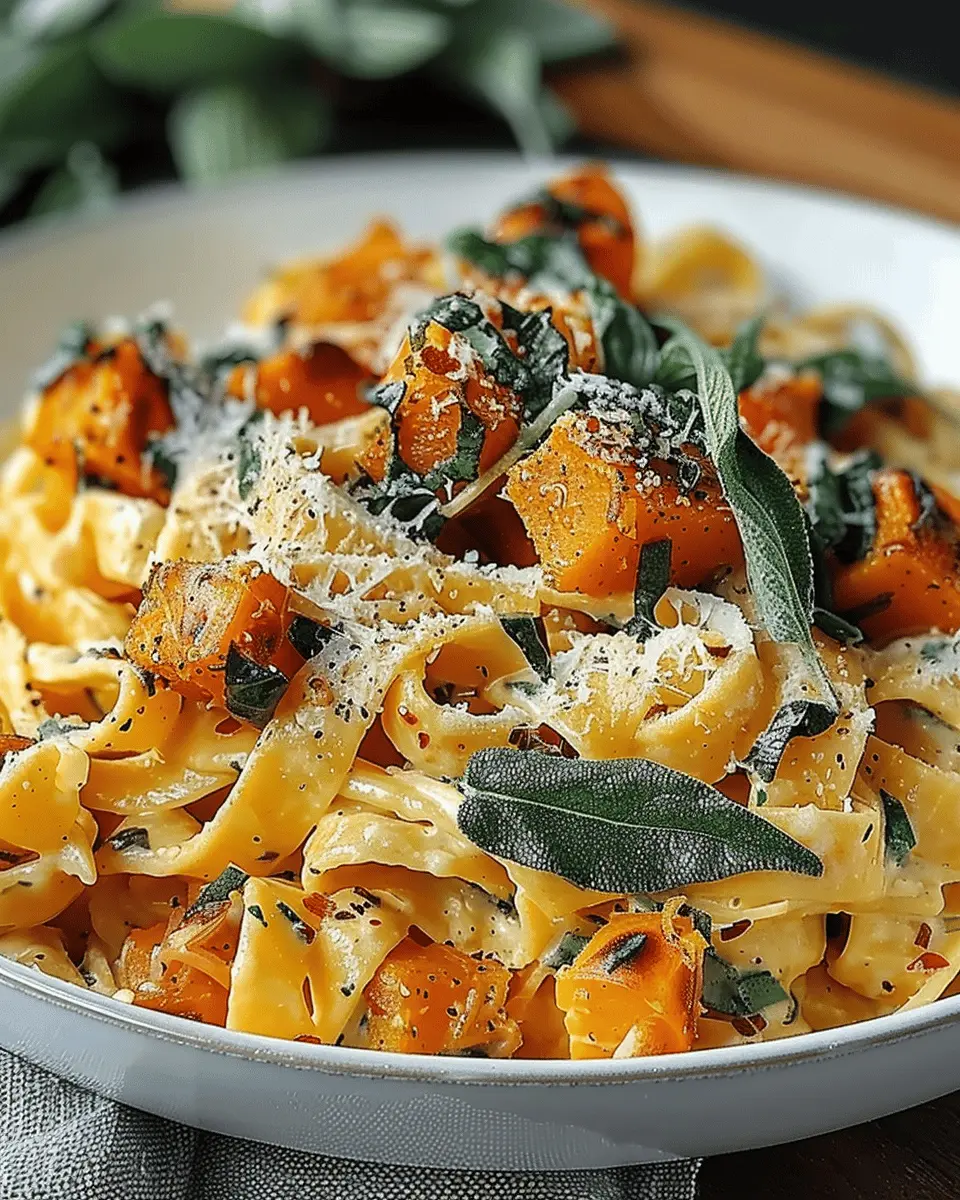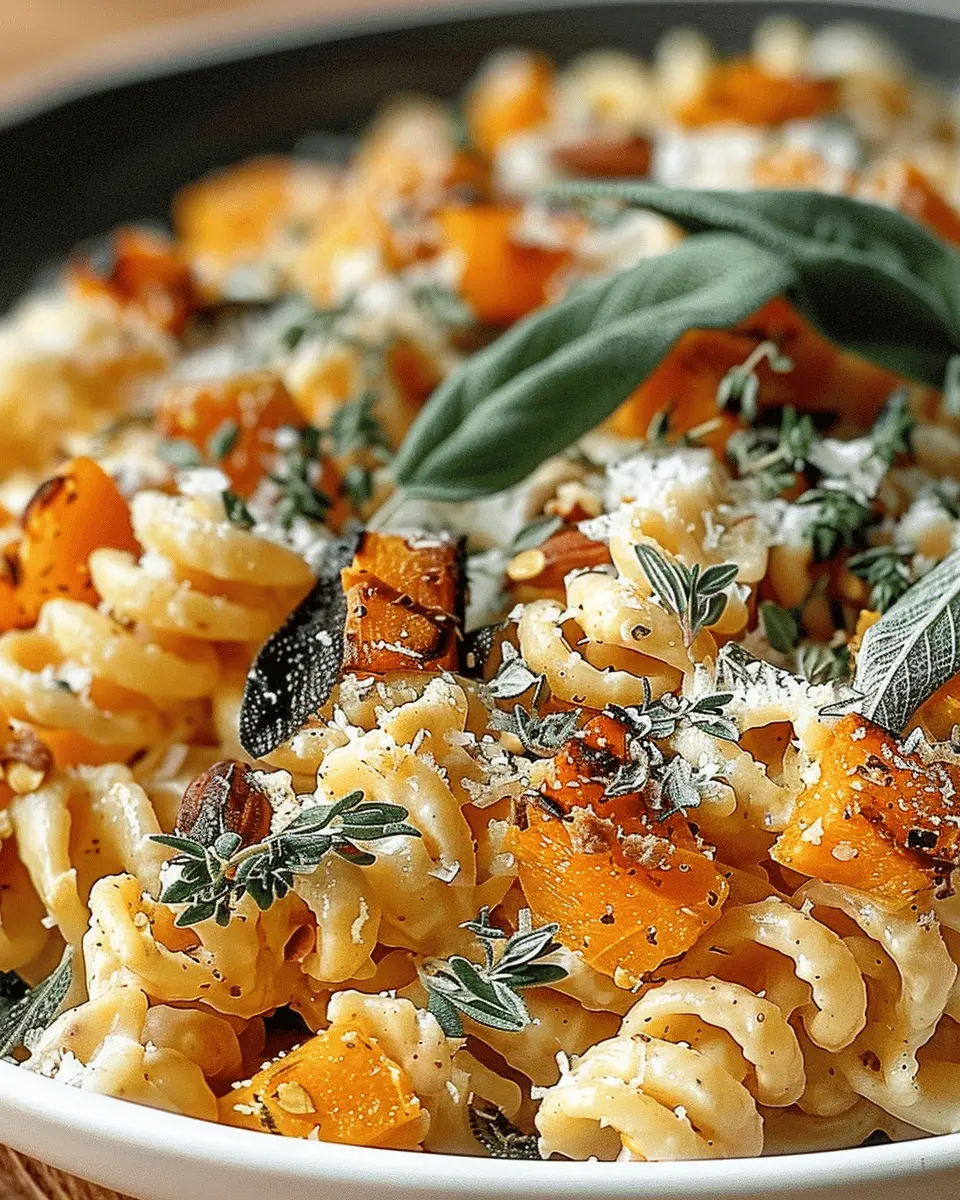Outline for Savory Butternut Squash & Sage Pasta
When it comes to cozy fall recipes, savory butternut squash and sage pasta stands out as a deliciously comforting dish that is perfect for weeknight dinners or special gatherings. With its vibrant flavors and inviting aromas, this pasta not only fills your belly but also warms your heart. Whether you’re a seasoned chef or a kitchen novice, this outline will guide you through every step of the process, ensuring a smooth cooking experience that results in an exquisite meal.
Introduction to Savory Butternut Squash & Sage Pasta
Have you ever noticed how certain foods can evoke feelings of warmth and happiness? Butternut squash is one of those magical ingredients—it’s sweet, nutty, and incredibly versatile. Combined with the earthy aroma of sage, this dish transforms a simple plate of pasta into something truly special. As someone who loves experimenting in the kitchen, I often find myself reaching for seasonal ingredients like squash to create hearty, satisfying meals that reflect the flavors of fall.
Ingredients You’ll Need
Before diving into the cooking process, let’s gather all the ingredients you’ll need. Having everything on hand will make your cooking experience much more enjoyable. Here’s the list for your savory butternut squash sage pasta:
-
For the Pasta:
-
12 oz of your favorite pasta (penne, fettuccine, or even whole grain)
-
Salt for boiling water
-
For the Sauce:
-
1 medium butternut squash, peeled and diced
-
1 tablespoon olive oil
-
2 tablespoons unsalted butter
-
1 medium onion, finely chopped
-
3-4 garlic cloves, minced
-
5-6 fresh sage leaves, chopped (or 1 teaspoon dried sage)
-
1 cup vegetable or chicken broth (low-sodium recommended)
-
Freshly ground black pepper and salt to taste
-
1/4 cup grated Parmesan cheese (optional for serving)
-
Cooked turkey bacon or chicken ham (optional for added protein)
Gathering all these ingredients ahead of time will not only streamline your cooking but also make it easier to adjust flavors as you go. If you want to explore the health benefits of taking in seasonal veggies like butternut squash, check out this article on the health benefits of squash.
Prepping the Ingredients
Preparation is essential for a smooth cooking process, especially when you’re using fresh ingredients. Here’s a quick rundown of what to do:
-
Prepare the Butternut Squash: Peel the squash carefully, as the skin can be tough. Once peeled, slice it in half, scoop out the seeds, and chop it into even-sized cubes. This ensures consistent cooking.
-
Chop the Aromatics: Finely chop the onion and mince the garlic to release their flavors when cooked. The more finely you chop them, the better they’ll mix into the sauce.
-
Slice the Turkey Bacon or Chicken Ham: If you’re adding these protein options, slice them into bite-sized pieces to mix in smoothly with the pasta.
Taking the time to properly prep your ingredients not only saves time while cooking but also helps develop deep flavors throughout the dish.
Cooking the Pasta Perfectly
Cooking pasta may seem straightforward, but there’s an art to it. Here’s how to do it right:
-
Boil Water: In a large pot, add plenty of water (about 4-5 quarts) and bring it to a rolling boil. Add a generous pinch of salt to the water. This is your chance to season the pasta while it cooks.
-
Cook the Pasta: Add the pasta of your choice and cook according to package instructions, usually around 8 to 12 minutes, depending on the type. Stir occasionally to prevent sticking.
-
Reserve Pasta Water: Before draining, make sure to reserve about a cup of the pasta water. This starchy water will help to thicken your sauce later.
-
Drain and Set Aside: Once al dente, drain the pasta but do not rinse it; you want to keep that starchy surface to help the sauce cling.
Pasta cooked perfectly is a basic but crucial skill; it truly makes a difference in the final dish. If you’re curious about pasta shapes and their ideal cooking times, take a look at this resource on the different types of pasta.
Making the Savory Sauce
Now comes the most exciting part: assembling all those delicious flavors into a sauce. Here’s how to create the savory butternut squash and sage sauce:
-
Sauté the Aromatics: In a large skillet, heat the olive oil and butter over medium heat. Add the chopped onion and garlic. Stir them occasionally until the onion becomes translucent and fragrant, about 3-4 minutes.
-
Cook the Butternut Squash: Add the diced butternut squash to the skillet. If you’re feeling adventurous, add a little chili powder or red pepper flakes for an extra kick. Stir frequently until the squash begins to soften, about 8-10 minutes.
-
Add Broth and Sage: Pour in the vegetable or chicken broth and add the chopped sage. Bring the mixture to a gentle simmer and continue cooking until the squash is tender (about 10 more minutes). You can mash some of the squash to create a creamier sauce, depending on your texture preference.
-
Season to Taste: With your taste buds guiding you, add salt, pepper, or even a squeeze of lemon juice to brighten the flavors. If you’ve decided to add turkey bacon or chicken ham, stir it in now to combine everything.
Creating a well-balanced sauce takes a bit of practice. Don’t hesitate to play around with different flavors or find a winning combination that suits your taste buds.
Bringing It All Together
Once both the pasta and the sauce are ready, you’re just about there! Here’s how to finish up your savory butternut squash and sage pasta masterpiece:
-
Combine Pasta and Sauce: In the skillet with your sauce, add the drained pasta. Toss everything together gently, ensuring that every strand or piece of pasta is coated in that luscious sauce.
-
Adjust Consistency: If the sauce is too thick, add a splash of reserved pasta water to loosen it up. If it’s too thin, let it simmer for a few minutes to reduce slightly.
-
Serve and Garnish: Dish the pasta into bowls and sprinkle a bit of grated Parmesan on top if desired. Fresh ground pepper can also add a nice finishing touch.
Serving pasta family-style creates a warm, inviting atmosphere. You may find people returning for seconds, indulging in that delightful mix of sweet butternut squash and fragrant sage.
Tips for Variations
One of the best aspects of cooking is making a recipe your own. Here are a few ideas for variations on this dish:
-
Add More Veggies: Feel free to toss in spinach, kale, or roasted Brussels sprouts for added nutrients and flavor.
-
Make It Creamy: Stir in some heavy cream or a dollop of crème fraîche for a creamy sauce that feels even more decadent.
-
Explore Different Proteins: Experiment with other proteins such as shrimp, tofu, or even spicy sausage to switch things up.
Every time you prepare this meal, it can feel like a brand new adventure while still being rooted in comfort.
Cleanup and Enjoying Leftovers
After enjoying your savory butternut squash and sage pasta, the last step is often the least favorite—cleanup! But here are some tips to make it easier:
-
Soak Pots and Pans: As soon as you’re done cooking, fill pots and pans with soapy water and let them soak. This makes washing up much quicker.
-
Portion Leftovers Wisely: If you have any leftovers (which is rare), store them in airtight containers. It keeps well in the fridge for about 3-4 days, making it an easy, delicious lunch option.
-
Reheat with Care: When you’re ready to enjoy your leftovers, reheat them gently on the stove with a splash of water or broth to bring back some moisture.
Cooking is not just about feeding our bodies; it’s also about nourishing our souls. Creating a dish like savory butternut squash and sage pasta can be a rewarding and joyful experience, especially when shared with friends or loved ones. By following this outline, you’ll not only create a stunning meal but also make lasting memories in the kitchen.
Whether you’re preparing for a cozy night in or hosting a small gathering, this pasta dish is sure to impress. So why not gather your ingredients, put on some comfortable music, and enjoy the simple joy of cooking? You might find that this savory dish becomes a staple in your culinary repertoire.

Introduction to Savory Butternut Squash & Sage Pasta
Why homemade pasta dishes are a game changer for busy professionals
In the whirlwind of daily commitments, preparing a homemade meal can feel daunting. However, savory butternut squash sage pasta simplifies this challenge, transforming kitchen time into a delightful experience. Ditching takeout for a nourishing homemade dish not only boosts your mood but also allows for creativity with flavors and ingredients. The act of cooking can serve as a great stress reliever, making it a win-win for busy professionals seeking balance in life. It’s time to embrace the joy of cooking and fuel your body with wholesome goodness.
The seasonal appeal of butternut squash
As autumn rolls in, so does the harvest of vibrant produce, with butternut squash stealing the spotlight. This delightful squash is not only nutrient-rich, packed with vitamins A and C, but also adds a sweet, earthy flavor to your pasta dish. The beauty of butternut squash lies in its versatility; it can be roasted, puréed, or sautéed, providing a canvas for a variety of textures and tastes. Seasonal ingredients like squash ensure that you’re eating fresh, while also supporting local farmers. Plus, for those looking for more inspiration, check out sources like The Spruce Eats for recipes highlighting this fantastic gourd.
A comforting dish to warm you up in autumn
Nothing says comfort like a warm bowl of pasta, especially during those crisp fall evenings. Imagine twirling strands of pasta coated in a creamy, savory sauce, with the aromatic notes of sage filling your kitchen. This butternut squash and sage pasta embodies the essence of autumn, wrapping you in warmth and nostalgia. The combination of flavors creates a comforting dish that’s perfect for a cozy night in or an elegant dinner with friends. It’s a reminder that food can bring people together, offering not just nourishment but also companionship.
Incorporating the rich flavors of butternut squash and sage into your pasta is a transformative experience. So grab your apron, and let’s dive into this delightful recipe that captures the essence of the season while making busy evenings a bit brighter.
Ingredients for Savory Butternut Squash & Sage Pasta
Overview of Essential Ingredients
Making savory butternut squash & sage pasta is all about using the right ingredients to create a comforting, flavorful dish. For this recipe, you’ll need:
- Fresh butternut squash: Sweet and creamy, it adds a rich texture.
- Sage: This herb introduces an earthy warmth that’s perfect for autumn evenings.
- Pasta: Choose your favorite type; farfalle or fusilli works wonderfully.
- Turkey bacon: This lean option adds a savory crunch.
- Vegetable broth: To enhance the squash’s flavor without overpowering it.
- Parmesan cheese: Adds a creamy finish.
Benefits of Using Fresh, Seasonal Produce
Opting for fresh and seasonal ingredients not only supports local farmers but also ensures maximum flavor and nutritional value. For instance, butternut squash is packed with vitamins A and C. According to the USDA, seasonal veggies can be richer in nutrients, making your savory butternut squash & sage pasta not just tasty but health-conscious too.
Explore local farmers’ markets to find the freshest harvest—you’re bound to discover a world of flavor there!
Suggested Variations for Dietary Preferences
This dish can easily be tailored to your dietary needs:
- Vegan: Skip the turkey bacon and use plant-based cheese.
- Gluten-Free: Swap traditional pasta for gluten-free alternatives.
- Protein-Packed: Consider adding chicken ham or even chickpeas for extra protein.
Flexibility is key in cooking, so feel free to mix and match these suggestions to suit your palate!

Preparing Savory Butternut Squash & Sage Pasta
Creating a delicious dish can feel intimidating, but preparing savory butternut squash sage pasta is surprisingly simple and rewarding. With just a few steps, you’ll have a comforting meal ready to impress your friends or treat yourself on a cozy evening. Let’s dive right in!
Preheat the oven for roasting the squash
Before you tackle the other elements of this dish, it’s essential to set the stage by preheating your oven. A hot oven will help caramelize the butternut squash, bringing out its natural sweetness and imparting a delightful depth of flavor.
- Set your oven to 400°F (200°C).
- While it warms up, prepare the squash. Cut it in half, scoop out the seeds, and dice it into bite-sized pieces. This will ensure that it roasts evenly.
- For added flavor, toss the squash with a drizzle of olive oil, a pinch of salt, and pepper.
Pop it in the oven for about 25-30 minutes until it’s tender and golden. The aroma will fill your kitchen and entice everyone around!
Cooking the pasta to perfection
While the squash roasts, it’s the perfect time to cook your pasta. This step may seem straightforward, but achieving the ideal texture can make a world of difference.
- Choose your pasta wisely: Fettuccine, penne, or even whole grain options work beautifully with this dish.
- Bring a large pot of salted water to a rolling boil, then add your pasta.
- Cook according to the package instructions, usually around 8-10 minutes, depending on the type. For the best results, aim for al dente—it should have a slight bite to it.
Once cooked, reserve about a half cup of the pasta water before draining. This starchy water will become a secret weapon later in creating a luscious sauce.
Sautéing the aromatics
Now that the squash is roasting and the pasta is cooking, let’s move on to the aromatics. The combination of garlic and fresh sage will create a fragrant base for your dish.
- Heat a skillet over medium heat and add a tablespoon of olive oil or a little butter for richness.
- Thinly slice 2-3 cloves of garlic and add them to the pan as soon as the oil is shimmering.
- After about a minute, when the garlic becomes fragrant but before it turns brown, add in 5-6 sage leaves (fresh is best; dried can work if needed). Sauté until both the garlic and sage are golden, which will take another 1-2 minutes.
Aromatics like these are the backbone of many dishes—don’t underestimate their impact on the final flavor profile!
Combining ingredients for a creamy sauce
With your squash roasted and aromatics sautéed, it’s time to bring everything together into a creamy sauce. You can use vegetable broth or even just the reserved pasta cooking water for this part!
- In the skillet with the sautéed garlic and sage, add the roasted butternut squash and a splash of the vegetable broth or reserved pasta water.
- Use a fork or potato masher to roughly mash some of the squash while leaving other pieces whole for texture. This creates a wonderful creamy base.
Now, consider adding a sprinkle of parmesan cheese or nutritional yeast for a non-dairy option to enrich the sauce. Stir everything together, allowing the flavors to meld harmoniously.
Tossing everything together for that cohesive flavor
Finally, it’s time to unite all the components.
- Add your cooked pasta to the skillet, followed by more reserved pasta water if needed, and toss gently to coat everything in the creamy sauce.
- Adjust seasoning with more salt, pepper, and a squeeze of lemon juice for brightness.
Serve your savory butternut squash sage pasta warm, garnished with extra sage or a sprinkle of cheese if desired. This dish not only delights the palate but also fills the soul with warmth and comfort.
And there you have it! Easy enough for any weeknight, yet delightful enough for a dinner party. Enjoy the flavors—the balance of sweetness from the squash, earthiness from the sage, and the creamy base all work together to create a truly comforting meal that feels like a hug in a bowl.
Variations on Savory Butternut Squash & Sage Pasta
When it comes to creating your own twist on savory butternut squash sage pasta, the possibilities are endless! Whether you’re looking to amp up the flavor, add some protein, or cater to dietary restrictions, here are several creative ideas to explore.
Adding Proteins Like Turkey Bacon or Chicken Ham
For those wanting a hearty addition, try including turkey bacon or chicken ham. Sautéing these before mixing them into your pasta not only adds a satisfying crunch but also layers of flavor. Turkey bacon is a leaner choice, seamlessly blending with the sweetness of squash. If you’re feeling adventurous, you might even consider adding some chopped chicken ham towards the end, letting it warm through for a savory boost.
Vegan Alternatives: Cream and Cheese Substitutes
If you’re leaning toward a plant-based version of savory butternut squash sage pasta, there are fantastic alternatives! For creaminess, consider coconut cream or cashew cream, both of which offer a luxe texture without dairy. Nutritional yeast is a wonderful cheese substitute that adds a cheesy flavor without the guilt. Additionally, experimenting with cashew cheese can elevate your dish while staying completely plant-based.
Spicing It Up: Alternative Herbs and Add-Ins
Feeling like your savory butternut squash sage pasta could use a little zing? Explore different herbs such as thyme or rosemary that can beautifully complement the dish. Toss in some red pepper flakes if you like a little heat, or roasted garlic for a deeper flavor profile. Nuts, like toasted walnuts or pine nuts, can add some great texture and a touch of elegance.
These variations not only enhance the dish but also allow you to cater to your guests’ preferences. Happy cooking!

Cooking Tips and Notes for Savory Butternut Squash & Sage Pasta
Secrets to Perfecting the Creamy Sauce
To achieve a velvety smooth sauce in your savory butternut squash sage pasta, blending is key! After roasting your squash, allow it to cool slightly before blending with broth. This ensures a creamy texture without any lumps. For extra richness, consider adding just a splash of heavy cream or a non-dairy alternative. Remember, balance is crucial; taste as you go and adjust seasoning.
Tips for Perfect Pasta Texture
Cooking your pasta to the right texture is essential for a delightful dish. Always cook your pasta to al dente, which means it should have a slight bite. This not only enhances the texture but allows it to absorb the flavors of the sauce better. A quick tip: reserve a cup of pasta water; you can add it to your sauce for the ideal consistency.
Storage Suggestions for Leftovers
If you’re lucky enough to have leftovers, let the pasta cool completely before storing. Use an airtight container and store in the fridge for up to three days. If your sauce thickens too much after refrigeration, simply stir in a bit of warm vegetable broth to bring it back to life. For longer storage, consider freezing portions in freezer-safe containers—just remember to leave room for expansion!
By following these tips, your savory butternut squash sage pasta can become a weeknight staple! For more pasta ideas and cooking techniques, check out Culinary Institute of America for expert tips and inspiration.
Serving Suggestions for Savory Butternut Squash & Sage Pasta
Creative plating ideas
When serving your savory butternut squash & sage pasta, think about aesthetics! Use a shallow, white bowl to showcase the vibrant colors of your dish. A sprinkle of crispy Turkey Bacon or chopped walnuts on top adds both texture and a delightful crunch. Consider using fresh sage leaves for garnish, curled artistically around the plate for a touch of elegance. You could also drizzle a bit of high-quality olive oil over the top to enhance the flavors visually and tastefully.
Ideal sides to complement the dish
To create a well-rounded meal, consider pairing your pasta with light sides. A simple arugula salad tossed with lemon vinaigrette will balance the richness of the dish. Roasted Brussels sprouts or sautéed green beans also make fantastic accompaniments; their slight bitterness contrasts beautifully with the sweetness of butternut squash.
Pairing with non-alcoholic beverages
Looking for the perfect drink? A sparkling water infused with fresh lime or a refreshing iced herbal tea can cleanse your palate while enjoying this comforting meal. For something warm, consider a spiced apple cider, which amplifies the autumnal flavors of the pasta. These beverages not only add a charming touch but also enhance your dining experience without overpowering the savory butternut squash & sage pasta.
For inspiration on more sides, check out this article on seasonal vegetables to perfectly complement your meal.
Time Breakdown for Savory Butternut Squash & Sage Pasta
Preparation Time
Getting ready for your delicious savory butternut squash & sage pasta doesn’t take long—about 15 minutes! Use this time to peel and chop the butternut squash, garlic, and sage leaves. As you prep, consider putting on your favorite playlist to vibe with while you work.
Cooking Time
Once everything’s prepped, the cooking process will take only 20-25 minutes. That’s right! You can have a hearty meal on the table in less than half an hour, making it perfect for a weeknight dinner.
Total Time to Serve the Meal
Add it all up, and you’re looking at around 40-45 minutes to enjoy your flavorful savory butternut squash & sage pasta. This quick turnaround is ideal for busy young professionals like you, balancing work and a healthy lifestyle. For more on efficient cooking, check out this time-saving kitchen guide. Happy cooking!
Nutritional Facts for Savory Butternut Squash & Sage Pasta
Nutritional Advantages of Butternut Squash
Butternut squash is not just delicious; it’s a nutritional powerhouse! Rich in dietary fiber, it aids digestion and helps maintain a healthy weight. Packed with antioxidants like beta-carotene, it supports heart health and boosts the immune system. Plus, its naturally sweet taste makes it a great addition to savory dishes. For more on the benefits of butternut squash, check out Healthline.
Caloric Breakdown of the Dish
When you indulge in savory butternut squash & sage pasta, you can feel good about your choice. This dish offers a filling, satisfying experience with roughly 450-600 calories per serving, depending on portion sizes and ingredients. It balances calories from complex carbohydrates, healthy fats, and proteins, making it a wholesome meal.
Key Vitamins and Minerals Present
This delightful pasta dish is brimming with essential nutrients:
- Vitamin A: Supports eye health and immune function.
- Vitamin C: Boosts collagen production, promoting skin health.
- Potassium: Vital for heart health and muscle function.
- Iron: Crucial for red blood cell production and energy levels.
Incorporating savory butternut squash sage pasta into your meals can enrich your diet with these vital nutrients, giving you energy while satisfying your taste buds!
FAQs about Savory Butternut Squash & Sage Pasta
Can I make this dish gluten-free?
Absolutely! To create a deliciously savory butternut squash sage pasta without gluten, simply swap regular pasta for your favorite gluten-free variety. There are many options available, including brown rice pasta and chickpea pasta, which not only taste great but also add a unique twist to the dish. Just be sure to check the cooking times, as gluten-free pasta can differ from traditional pasta.
How do I make it lighter in calories?
If you’re looking to lighten your savory butternut squash sage pasta, there are several easy adjustments you can make:
- Use less cream: Reduce the amount of heavy cream or replace it with a lighter version, such as half-and-half or a plant-based alternative.
- Add more veggies: Incorporate spinach or kale for added nutrients and fiber without a lot of calories.
- Control portion sizes: Keep an eye on your servings to enjoy this dish while staying mindful of calorie intake.
What are the best substitutes for heavy cream?
There are plenty of delicious alternatives to heavy cream that can still give your savory butternut squash sage pasta a creamy texture:
- Coconut milk: For a dairy-free option, coconut milk adds richness and a hint of sweetness.
- Greek yogurt: This is a protein-packed option that adds creaminess, especially if you prefer a tangy flavor. Just stir it in at the end to prevent curdling.
- Silken tofu: Blend it until smooth for a creamy texture without the calories of heavy cream.
Using these alternatives not only lightens the dish but can also cater to dietary preferences. For more tips on cooking with healthy substitutes, check out resources from The Nutrition Source or Healthline.
Feel free to experiment with these options based on your preferences and let your creativity shine in the kitchen!
Conclusion on Savory Butternut Squash & Sage Pasta
Recap of Why This Dish is a Must-Try
The savory butternut squash and sage pasta beautifully blends flavors and textures, making it a delightful centerpiece for any meal. With creamy butternut squash and aromatic sage, you can create an appealing dish that’s packed with nutrients and perfect for any occasion. It’s not just a feast for your taste buds; it’s an impressive dish to wow your friends or loved ones during a cozy dinner night!
Encouragement to Experiment in the Kitchen
Don’t hesitate to put your twist on this recipe! Consider adding Turkey Bacon for a satisfying crunch or toss in some veggies for added color and nutrition. Cooking is about exploring, so let your creativity shine! For more cooking inspiration, check out resources like America’s Test Kitchen or Food52. Enjoy the process and have fun with your savory butternut squash sage pasta adventure!
PrintSavory Butternut Squash Sage Pasta with Turkey Bacon Delight
A delicious and hearty pasta recipe featuring butternut squash, sage, and turkey bacon, perfect for any dinner.
- Prep Time: 15 minutes
- Cook Time: 25 minutes
- Total Time: 40 minutes
- Yield: 4 servings 1x
- Category: Pasta
- Method: Stovetop
- Cuisine: Italian
- Diet: Gluten-Free
Ingredients
- 1 pound butternut squash, peeled and diced
- 8 ounces pasta of choice
- 4 slices turkey bacon, chopped
- 1 tablespoon olive oil
- 2 cloves garlic, minced
- 1 teaspoon fresh sage, chopped
- Salt to taste
- Black pepper to taste
- 1/4 cup grated Parmesan cheese
Instructions
- In a large pot, cook the pasta according to package instructions. Drain and set aside.
- In a skillet, heat olive oil over medium heat. Add chopped turkey bacon and cook until crispy.
- Add diced butternut squash and garlic to the skillet. Cook until the squash is tender.
- Stir in cooked pasta, fresh sage, salt, and black pepper. Mix well.
- Serve topped with grated Parmesan cheese.
Notes
- For a vegetarian option, substitute turkey bacon with mushrooms.
- This pasta can be served warm or cold as a salad.
Nutrition
- Serving Size: 1 plate
- Calories: 350
- Sugar: 3g
- Sodium: 600mg
- Fat: 12g
- Saturated Fat: 3g
- Unsaturated Fat: 7g
- Trans Fat: 0g
- Carbohydrates: 50g
- Fiber: 5g
- Protein: 15g
- Cholesterol: 25mg
Keywords: Savory Butternut Squash, Sage Pasta, Turkey Bacon











